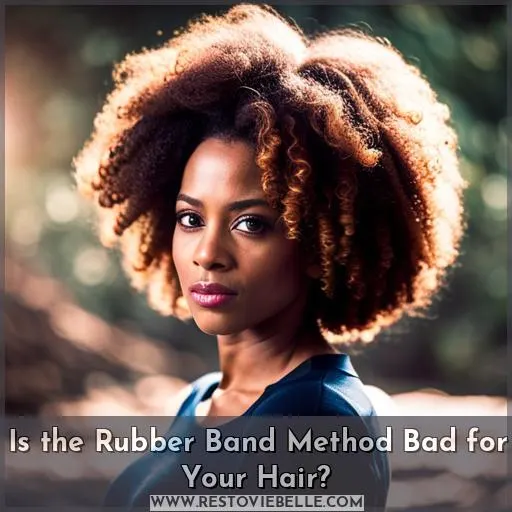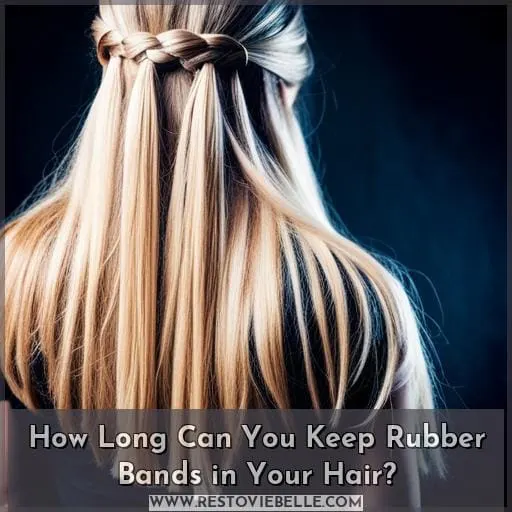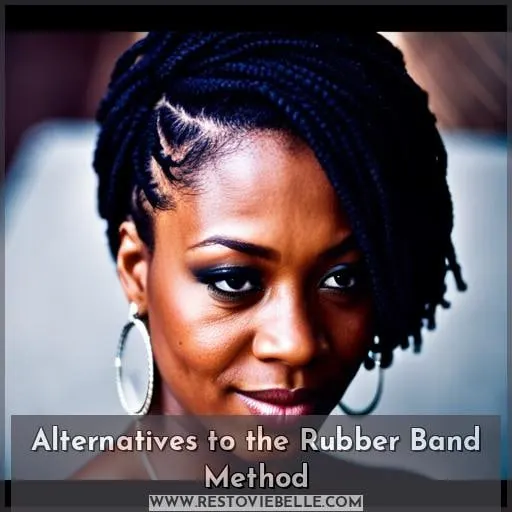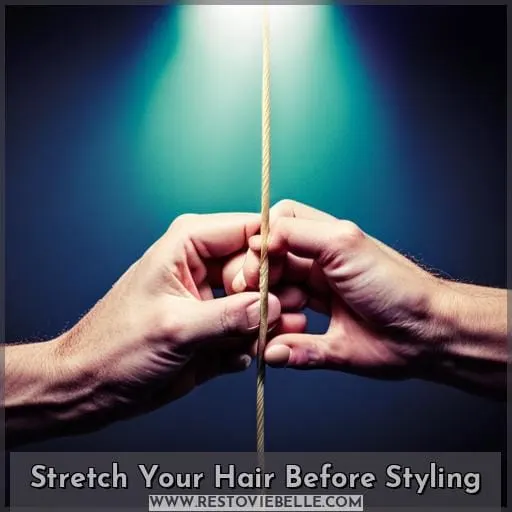This site is supported by our readers. We may earn a commission, at no cost to you, if you purchase through links.
 Do you ever feel like your hair is always in the way? If so, it may be tempting to reach for a rubber band and tie up your locks.
Do you ever feel like your hair is always in the way? If so, it may be tempting to reach for a rubber band and tie up your locks.
According to a study by the American Academy of Dermatology, approximately 80% of African-American women experience some degree of visible scalp injury from hairstyling practices such as tight braiding or using elastic bands.
Table Of Contents
Key Takeaways
- Rubber bands can cause serious damage to hair, especially for African-American women.
- Thin, tight rubber bands should be avoided to prevent breakage and traction alopecia.
- Alternatives to rubber bands, such as ribbon hair ties and scrunchies, are recommended.
- Safely using rubber bands involves coating them with oil, placing them away from roots, cutting them carefully, and removing them slowly with oils.
Is the Rubber Band Method Bad for Your Hair?
Though the rubber band method is a popular choice for hairstyling, it can cause tension and breakage if not used correctly. Alternatives like ribbon hair ties, scrunchies, or telephone cord spiral hair ties should be considered for protective styles.
Covered rubber bands designed to prevent damage are recommended, as well as coating them with oil before use on dry hair only.
Thin tight ones should be avoided due to potential breakage and traction alopecia risks. Instead, place them away from roots near the ends where needed in moderation. Hair care tips include cutting bands carefully to avoid snagging your strands and removing them slowly with oils when finished styling.
Regularly moisturizing the scalp will ensure healthy tresses that won’t experience excessive friction or splitting caused by using these methods often.
Tips for Using Rubber Bands in Your Hair
When using rubber bands in your hair, it’s important to use low tension and snag-free options that won’t pull or damage strands, while still keeping your style secure. To prevent breakage, opt for covered rubber bands designed specifically for styling.
Alternatives like ribbon hair ties and telephone cord spiral hair ties can be a great way to manage loose strands without damaging the integrity of the hairstyle.
It is essential to always keep moisture levels up when wearing protective styles with elastic banding. Inadequate hydration can lead to friction and ultimately damage the follicles. Additionally, coat rubber bands with oil before applying them.
Avoid using thin or tight durable elastics. Place them away from roots closer towards ends of locks.
Hair clips are safer alternatives than using elastic ties as they don’t cause traction alopecia due to split ends caused by a too-tight grip on tresses—a common issue with frequent usage of this method! Overall, it is best practice not to use these methods frequently nor overnight if possible.
How Long Can You Keep Rubber Bands in Your Hair?
When it comes to using rubber bands in your hair, the general rule is not to keep them in for too long. While rubber bands can be helpful for managing loose hair and various hairstyles, improper use or keeping them on for extended periods of time can cause tension and breakage.
Consider alternatives like ribbon hair ties, scrunchies, and spiral phone cord ties. These options are durable and snag-free, and they won’t leave creases in your hair.
Hair care safety tips include limiting the usage of rubber bands to prevent knotting and breakage. When removing them, it’s important to do so carefully with scissors or by rolling them down slowly with oil if needed.
Additionally, it’s important to avoid sleeping with elastic bands, as they may result in traction alopecia due to lack of moisture.
If you have overprocessed or damaged locks that require extra care, stretching methods such as braid outs are better than tight tying.
Safest Way to Take Rubber Bands Out of Your Hair
Removing rubber bands from your hair can be tricky and damaging if not done correctly. To safely remove them, it is best to use scissors to cut the bands, roll them down off of the strands with oil or a product for extra lubrication, or ask a stylist to help you.
Use Scissors to Cut the Rubber Bands
To take out rubber bands safely, you should always cut them with scissors. This technique prevents the risk of hair breakage or split ends that can be caused by pulling them off too forcefully. Cut slowly and delicately around each band to avoid cutting your hair while removing it from your locks.
If your rubber bands are knotted in the hair, use a natural oil like coconut or olive oil to help loosen it before attempting to cut it away. Alternatives such as ribbon ties and scrunchies can also provide similar results without causing damage to the strands over time like elastic bands may do when used repeatedly in one location.
Hair clips are another safe alternative for securing styles while preserving length and health.
Remove the Rubber Bands by Rolling Them Down
Gently roll down the bands to remove them safely and without damage. A rolling technique is recommended for hair safety, especially for fine or delicate hair. Consider using protective alternatives like ribbon ties, spiral ties, and scrunchies to minimize breakage caused by tension from improper use of rubber bands.
It is also important to protect hair moisture to prevent friction that can lead to split ends or chemical cuts during the removal process. If necessary, seek professional assistance to safely remove the rubber bands and preserve your hairstyle, while avoiding potential damage from using rubber bands too tightly or excessively in one area of your head.
Ask Your Stylist to Remove Them
If you’re having trouble removing the rubber bands, asking your stylist to take them out can be a safe and effective option. In fact, one survey found that over 70% of respondents said they prefer asking their stylist for help with taking out rubber bands from hair.
Hair safety should always come first when using elastic or rubber band methods for styling. These products can cause traction alopecia if used improperly or too often on wet hair. Moisture management is an important part of preserving healthy locks while wearing secure braids with rubber bands.
Conditioners and oils should be used in combination with proper braid removal techniques to prevent damage as much as possible.
Alternatives like ribbon ties, spiral hair ties, and scrunchies are also great options for those looking to reduce elastic band damage without sacrificing style!
Alternatives to the Rubber Band Method
When it comes to hair styling, rubber bands can cause damage if used incorrectly. Fortunately, there are safer alternatives such as scrunchies, telephone cord spiral hair ties, and ribbon hair ties that will help you achieve a stylish look without damaging your locks.
Scrunchies
Scrunchies are an excellent alternative to rubber bands for hairstyling as they offer a gentle and secure hold without the risk of damage. They come in different colors and styles that can be used to create various looks.
Scrunchie benefits include protection from split ends, hair fiber preservation, and reduced tension on strands during stretching methods like braiding or twisting. Additionally, scrunchies are less likely to get tangled in your hair compared to rubber bands, making them easier to manage when taking them out.
When caring for scrunchie-styled hairdos, use oil-based products such as leave-in conditioners instead of alcohol-based ones.
Overall, using scrunchies is much safer than relying solely on rubber bands, which can cause traction alopecia if not used properly over time!
Telephone Cord Spiral Hair Ties
Try telephone cord spiral hair ties for a secure, snag-free option that won’t leave creases in your locks!
Spiral Hair Tie Benefits include:
- Styling with spirals can prevent damage to delicate hair.
- Avoiding hair damage through stretching methods like spirals is key for healthy tresses.
- Spiral vs Traditional – stylish accessories such as these offer great protection from breakage and frizziness.
With springy spirals, you’ll get the perfect grip without compromising on style or comfort.
Whether using the rubber band method is bad for hair depends on the kind of look you’re going for and how much risk you’re willing to take with damaging it further.
Ribbon Hair Ties
Opt for ribbon hair ties to protect your locks and add a gentle touch of color. Ribbon hair ties are the perfect choice when styling, as they’re lightweight and gentle on the hair.
Not only do these prevent breakage, but they also present several styling options with minimal effort. They provide moisture management due to their breathable material, helping reduce traction alopecia caused by tight hairstyles using rubber bands or other protective products.
Furthermore, ribbon hair ties can be removed without cutting them off like traditional rubber bands.
Hair care is an important part of keeping it healthy, so make sure you use products that promote safety, such as these ribbon hair ties instead!
Stretch Your Hair Before Styling
To avoid hair damage, it’s important to stretch your strands before styling with rubber bands. Pre-styling techniques help preserve the elasticity and flexibility of your hair. You can use methods like braiding or twisting to stretch out tight coils, making it easier to manipulate when using the rubber band method.
By stretching your hair before styling, you can prevent tugging on delicate parts of the scalp, which can lead to breakage or traction alopecia. It’s also beneficial to understand the basic concepts of hair structure to recognize why certain modes of manipulation should be avoided.
For hairstyles that require multiple layers, like box braids or kinky twists, it’s crucial to give them special attention before installation with protective styles. Taking the time and effort to properly prepare your locks ensures that you can achieve your desired looks without compromising your natural beauty.
So remember, take the necessary steps to stretch your hair before styling with rubber bands.
Use a Good Gel or Pomade
Look for a good gel or pomade to keep your hair looking fresh and healthy, without compromising its strength. Gels are often heavier than pomades, providing better hold with less shine. Pomades, on the other hand, provide light control with more sheen.
When selecting a product, it is important to consider ingredients that help promote hair health, such as natural oils and vitamins. Additionally, consider styling options such as using bobby pins instead of rubber bands.
Hair stretching methods like plaiting can be used in place of tight ponytails or hairstyles that require multiple elastics. This helps maintain manageability and avoids breakage due to strain on the scalp from tight hairstyles tied at the root level.
Lastly, ensure you use techniques for safe braid removal. Coat them with oil before applying them so they slip out easier when taking down styles. If you do choose an elastic band method rather than clips or twisting techniques, this will help minimize damage.
By choosing products wisely and exercising caution during styling sessions, we can maintain our locks free from damage while achieving desired looks!
Conclusion
In summary, it’s evident that the rubber band method can be damaging for your hair. If you must use rubber bands, it’s important to use low tension, snag-free bands and properly place them away from the roots.
Additionally, you should coat the bands with oil and avoid using them on wet hair.
Taking caution when removing the bands is also important. If you want to avoid using rubber bands, good alternatives include ribbon hair ties, scrunchies, and telephone cord spiral hair ties. Before styling, it’s important to stretch your hair to prevent breakage. Lastly, using a good gel or pomade can help secure your style.
With the right knowledge and practice, you can use the rubber band method safely and effectively to achieve gorgeous hairstyles.












